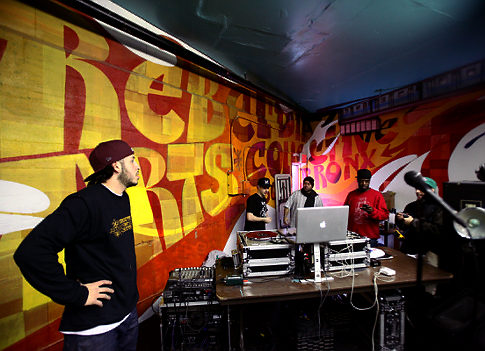The hip-hop community center – housed on the second floor of an abandoned candy factory under the Bruckner Expressway – oozes youthful energy.
Swirling graffiti covers the walls of the center and rap music throbs from a closet studio. Rodrigo and Gonzalo Venegas, brothers who make up the hip-hop group Rebel Diaz, helped found the collective two years ago.
“Hip-hop started in the Bronx, but the Bronx had no hip-hop community center,” said Rodrigo Venegas, 30. “We wanted to give young people a space to learn and perform.”
Now 20 members strong, the collective screens films, hosts panel discussions and runs art workshops at the 4,000-square-foot loft on Austin Place, in Mott Haven. The space boasts a hard-edged vibe reminiscent of hip-hop’s early days.
“When we first got here, it looked like a bomb had been dropped,” said Patty Dukes, 31, one half of the hip-hop group Circa ’95. “We worked hard to make it what it is today.”
Every afternoon, budding singers, comedians, poets and deejays swarm the collective to collaborate and laugh. Most stay late, thankful for a safe haven away from the gangs and the street.
The collective meets as a whole on Monday nights to discuss funding and programming.
“We keep people out of trouble,”said YC the Cynic, a 20-year-old rapper from Hunts Point. “You learn things here you don’t learn at school.”
Community centers across the city are slashing services due to harsh budget cuts. But the Rebel Diaz Arts Collective won a $35,000 grant from the Union Square Awards last December, and plans to add new workshops this spring.
Its members help pay the bills and run the space as unpaid volunteers, selling t-shirts and mixtapes to stay afloat. The collective has no president and no CEO. It receives some funding from CITGO, the Venezuelan oil company.
“A lot of the people who work for nonprofits come here trying to empower our community,” said Venegas, a Chicago transplant who lives in Hunts Point. “But we are the community and we already have power. We just need to organize.”
Politically, the collective leans far left. Workshops have covered the history of the Black Panthers and the Young Lords. Members painted a rooftop mural – visible from the Bruckner Expressway – that reads “No human being is illegal,” a nod to Arizona‘s immigration law and the Central American immigrants flooding Mott Haven.
The collective serves an eclectic bunch, including a Chilean graffiti artist, a college professor and a deejay from Milwaukee, and shares the factory space with a group of elderly South American painters. Its members range from 14 to 33 years old. One night, a young poet brought her father, a police officer, to watch her perform.
In the converted factory space, books about hip-hop and Latino culture lay scattered about on rummage sale tables.
“We include an age group that gets ignored by most nonprofits – 18 to 22-year-olds,” said Venegas. “They may not be youth, but they’re still developing.”
Too often, hip-hop and graffiti get a bad rap they don’t deserve, said Dukes.
“We have a such a safe, sweet environment here,” she said. “It’s not what you’d expect from a hip-hop community center.”
BY DANIEL BEEKMAN
DAILY NEWS



